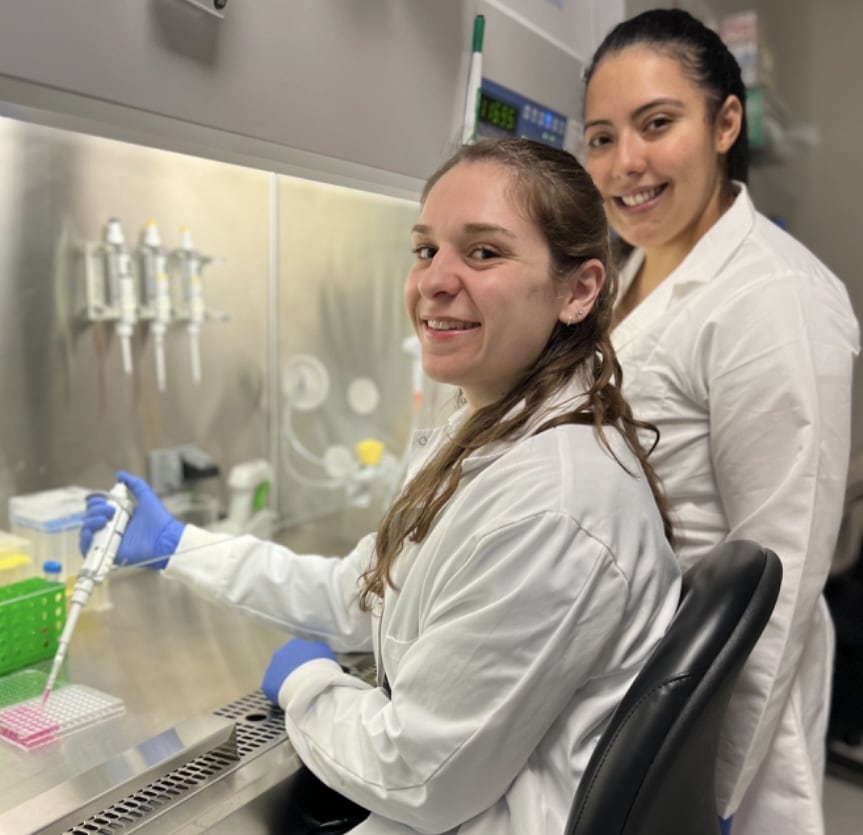
U-M BME Researchers Examine Ways to Control Immune Responses with Flexible PEG Synthetic Linkers
The ultimate goal is to provide drug-free transplantation in the future.

The ultimate goal is to provide drug-free transplantation in the future.
“Bending the Rules: Amplifying PD-L1 immunoregulatory function through flexible PEG synthetic linkers” was published this month by Tissue Engineering Part A. The article was the inaugural study to come from the lab of Maria Coronel, Assistant Professor, Biomedical Engineering.
“In our lab, we design technologies for immune programming,” Dr. Coronel said. “The goal is to develop technologies that enable cells to achieve self-tolerance towards implants so that patients who undergo transplant treatments don’t have to take immunosuppressant drugs chronically.”
The ultimate goal is to provide drug-free transplantation in the future. “In this particular study, we aimed to delve into the biophysics of protein interactions and grasp the intricate dynamics of this process,” she said. “We aimed to elucidate that our bodies don’t operate like simple on/off switches; rather, they respond akin to fine-tuning a radio dial, with nuanced responses resulting from subtle adjustments.”
Dr. Coronel added: “By implementing minor modifications to the polymers utilized for presentation, we’ve observed a remarkable enhancement in the immunoregulatory effects of the proteins resulting in over a 50% increase in the retrieval of regulatory cells from in vitro cultures and a 20-fold rise in in vivo transplant models. Such findings hold immense promise for our efforts in delivering biological analogs for transplantation and offer substantial progress in cell manufacturing. Utilizing this simple approach can effectively tackle the existing challenges related to the variability in regulatory T cell manufacturing.”
Dr. Coronel noted that there is a big push for manufacturing regulatory T-cells in the context of treating people with autoimmune diseases like type 1 diabetes and for the induction of tolerance in transplant recipients.
“We’re trying to create these regulatory T-cell populations from the patient and then reintroduce them back into the body, allowing these cells to perform their intended functions,” she said. “However, this is a costly undertaking, and numerous clinical trials have faced setbacks due to difficulties in obtaining adequate cell dosages. Through our approach, we can effectively double the yield of cells, making it a simple addition to standard cell-manufacturing practices without necessitating significant changes. This can address the challenge of insufficient yield during manufacturing without significantly increasing costs. This is crucial to us as we are strong advocates for democratizing therapies and ensuring that state-of-the-art treatments are accessible to a broader population.”
Dr. Coronel said that in terms of cell manufacturing, clinical trials are currently ongoing to establish Treg therapy; however, broader implementation in the context of transplantation is at least a decade away due to the need for meeting regulatory specifications and addressing challenges concerning dosage, specificity, and cryopreservation. As patient studies come into play, there is a need for increased monitoring of patients as well as the manufacturing processes involved in production.
Dr. Coronel added that it is a monumental moment as a new PI to publish her lab’s first paper. “It is very exciting to show the students that the ideas and the things that we do in the lab can have an impact in many different applications,” she said. “They’ve only been with me for a year-and-a-half, and they’ve been able to accomplish a lot, so that makes me very proud as a young assistant faculty.”
Graduate student Nicole Racca was the First Author of this article and was excited to focus on the study. “The project that culminated in this paper was a really exciting and pivotal experience for my career here at the University of Michigan,” Racca said. “I initially started working on this as a side project in addition to my thesis, but the exciting outcomes from this work led me to focus on this work full time. Very quickly into this project I became deeply invested in the outcome, and it was interesting to work on a key immunomodulatory concept with great clinical translation potential. Throughout the process of this work, I gained a lot of experience with new complex analysis techniques that I will continue to use during my thesis work. Overall, I had an amazing experience working with Dr. Coronel and our collaborators Dr. Haval Shirwan, and Dr. Esma Yolcu from the University of Missouri, and I am excited to see what more is to come from this research and collaboration.”